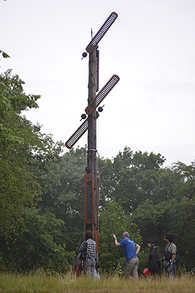The "Albert Einstein" Science Park on Telegrafenberg in Potsdam, formed by Helmholtz Centre Potsdam - GFZ German Research Centre for Geosciences, Alfred Wegener Institute for Polar and Marine Research (AWI, Location Potsdam), and Potsdam Institute for Climate Impact Research (PIK), is one of the locations for science in Germany richest in tradition.
For about 150 years the Telegrafenberg is a location of research institutions, where impulses are set and spread globally.
Here, the world's first Astrophysical Observatory was build, the cradle of scientific geodesy and systematic measuring of the Earth's magnetic field is located, and here is one of the birthplaces of German meteorology.
At this point you will find external content from Northwestern University designed by the GFZ editorial team, which supplements the article. It is a timeline ("knight lab"). You can display the content with one click and hide it again with one button click.
I consent to external content being displayed to me. This allows personal data to be transmitted to third-party platforms. More about this in our privacy policy.
Die Baugeschichte des Telegrafenberges als Campusplan
1832/33: The Telegrafenberg got its name as a station of an optical telegraphy line built to link Berlin with Koblenz via Potsdam.
1870: The Royal Prussian Geodetic Institute is founded in Berlin under its first director, Lieutenant-General Johann Jacob Baeyer, as a research institute of the European Project for the Measurement of the Figure of the Earth. After the Geodetic Institute transferred to Potsdam, Baeyer's successor Friedrich Robert Helmert established Potsdam's worldwide reputation as a centre for geodesy and gravity research.
1881: In the basement of the Astrophysical Observarory Potsdam, today "Michelson Haus" building A31, the historic Michelson experiment is carried out. While trying to prove the existence of a substance ether that was postulated to be the medium of the propagation of light Albert Michelson proved its non-existence. Michelson was honored with the Nobel Prize in 1907 for his optical precision instruments and his therewith realised spectroscopic and metrologic experiments.
1889: In Potsdam the first teleseismic recording is taken of an earthquake near Japan by Ernst von Rebeur-Paschwitz.
1890: The Geomagnetic Observatory is founded in Potsdam.
1892: Inauguration of the Geodetic Institute at the Telegrafenberg - today one of the GFZ main buildings (A 17).
1898-1904: Measurements of the absolute gravity value in Potsdam which in 1909 is accepted as the international reference until 1971.
1930: Commissioning of the Adolf-Schmidt-Observatory for Geomagnetism in Niemegk.
1933: Two quartz-chronometers are put into operation for the official time-service. Precise time measurments provide the basis for observing fluctuations in the Earth's rotation.
1969: The Geodetic and the Geomagnetic Institutes in Potsdam, the Geotectonic Institute in Berlin (founded in 1946), and the Geodynamic Institute in Jena are combined to form the Central Institute of Physics of the Earth.
1985: Publication of an earthquake register for eastern Germany, ranging from 823 - 1984.
1992: Foundation of the GeoForschungsZentrum Potsdam GFZon the 1st of January. As the first of its kind, GFZ unites all sciences of the solid earth under one roof.
1995: Launch of GFZ's first own satellite mission: the laser satellite GFZ 1 is put into orbit from the space station MIR (April, 19).
1996: Start of the International Continental Drilling Program ICDP, lead managed by the GFZ.
1998: International UN Early Warning Conference (EWC´98) at the GFZ on Early Warning Systems for natural catastrophes.
Inauguration of the new GFZ-Buildings (building B to H), June, 2.
1999: Inauguration of the renovated Geodetic Institute, today the residence of Department 1 and the library on July, 6.
2000: Launch of the GFZ-Satellite CHAMP (Challenging Minisatellite Payload) on July, 1.
2002: Launch of the GRACE tandem satellites (Gravity Recovery and Climate Experiment) on March, 17.
2005: On behalf of the German Ministry for Science and Education, in January the Helmholtz Association under the lead of GFZ begins to set up an tsunami early warning system for the Indian Ocean (GITEWS). GITEWS is part of the flood aid programme of the Federal Government and is set into operation after the Tsunamy of December 26th in 2004, in November 2008. On March 29, 2011 GITEWS is handed over to the Indonesian Government.
2008: The GeoForschungsZentrum Potsdam gets a new name: Helmholtz Centre Potsdam — GFZ German Research Centre for Geosciences on June, 17.
2009: Inauguration of the building A20 (16.01.2009).
2012: Inauguration of the buildings A69/70 (21.08.2012).
2013: Inauguration of the Helmholtz Lab for the Geochemistry of the Earth Surface HELGES (June, 11.) and the new SIMS-Lab(Sekundary Ion Mass Spectrometer, August, 20).
2013: Launch of the trio satellite mission SWARM to explore Earth's magnetic field (22. November).
2015: Inauguration of the Observatory "GONAF" - Turkey
2017: "Goldenes Lot" 2017 for Tsunami Early Warning System by Jörn Lauterjung
2018: Launch of the satellite mission "GRACE follow-on".
2019: Helmholtz Innovation Labs: The "3D Underground Seismic Lab" and the "FERN.Lab - Remote Sensing for Sustainable Resource Use" will be funded with a total of 3.8 million euros.
2020: Potsdam Imaging and Spectral Analysis (PISA) Facility opens: State-of-the-art imaging and spectral technologies for all kinds of research applications.
2021: GEOBIOLAB inaugurated. The "Helmholtz Laboratory for Integrated Geoscientific-Biological Research" (GeoBioLab for short) is opened. Its primary purpose is to research the deep biosphere and the interactions of the biosphere with the geosphere and the climate.



